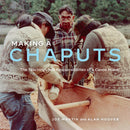Description
Making a Chaputs : The Teachings and Responsibilities of a Canoe Maker is written by Joe Martin, a member of the Tla-o-qui-aht First Nation, and Alan L. Hoover.
Tla-o-qui-aht master canoe maker Joe Martin, in collaboration with former museum curator Alan Hoover, describes the meaning and method behind one of the most vivid and memorable symbols of the Northwest Coast: the dugout canoe. Both artform and technological marvel, the chaputs carries Indigenous cultural knowledge passed down through generations, not only of the practical forestry and woodworking that shape every canoe, but also of the role and responsibilities of the canoe maker.
The text includes both a step-by-step explanation of the canoe-making process from tree selection onward (carefully described and dynamically illustrated) and the personal histories of a number of Joe's canoes, encompassing their planning, creation, cultural significance and role in the process of reconciliation. The teachings Joe received from his father and the expertise he has gained in a lifetime of canoe-making are recorded here in his own words for generations to come.
Joe Martin is a member of the Tla-o-qui-aht First Nation. He is a recognized master canoe maker who, as of 2014, estimated he had made more than 60 canoes. In addition to making canoes and mentoring apprentices, he teaches both schoolchildren and others about the cultural traditions of the Nuu-chah-nulth peoples. In 2013, Joe was one of five Indigenous artists who were awarded the BC Creative Achievement Award. He is also an elected councillor of the Tla-o-qui-aht First Nation government.
Alan Hoover worked for 33 years at the Royal BC Museum as a curator and manager. He edited the anthology Nuu-chah-nulth Voices, Histories, Objects & Journeys (2000), co-authored with Eugene Arima The Whaling People of the West Coast of Vancouver Island and Cape Flattery (2011) and published a book on canoe racing titled Southern Northwest Coast Indigenous Canoe Racing: A Brief History (2018).
Tla-o-qui-aht master canoe maker Joe Martin, in collaboration with former museum curator Alan Hoover, describes the meaning and method behind one of the most vivid and memorable symbols of the Northwest Coast: the dugout canoe. Both artform and technological marvel, the chaputs carries Indigenous cultural knowledge passed down through generations, not only of the practical forestry and woodworking that shape every canoe, but also of the role and responsibilities of the canoe maker.
The text includes both a step-by-step explanation of the canoe-making process from tree selection onward (carefully described and dynamically illustrated) and the personal histories of a number of Joe's canoes, encompassing their planning, creation, cultural significance and role in the process of reconciliation. The teachings Joe received from his father and the expertise he has gained in a lifetime of canoe-making are recorded here in his own words for generations to come.
Joe Martin is a member of the Tla-o-qui-aht First Nation. He is a recognized master canoe maker who, as of 2014, estimated he had made more than 60 canoes. In addition to making canoes and mentoring apprentices, he teaches both schoolchildren and others about the cultural traditions of the Nuu-chah-nulth peoples. In 2013, Joe was one of five Indigenous artists who were awarded the BC Creative Achievement Award. He is also an elected councillor of the Tla-o-qui-aht First Nation government.
Alan Hoover worked for 33 years at the Royal BC Museum as a curator and manager. He edited the anthology Nuu-chah-nulth Voices, Histories, Objects & Journeys (2000), co-authored with Eugene Arima The Whaling People of the West Coast of Vancouver Island and Cape Flattery (2011) and published a book on canoe racing titled Southern Northwest Coast Indigenous Canoe Racing: A Brief History (2018).


